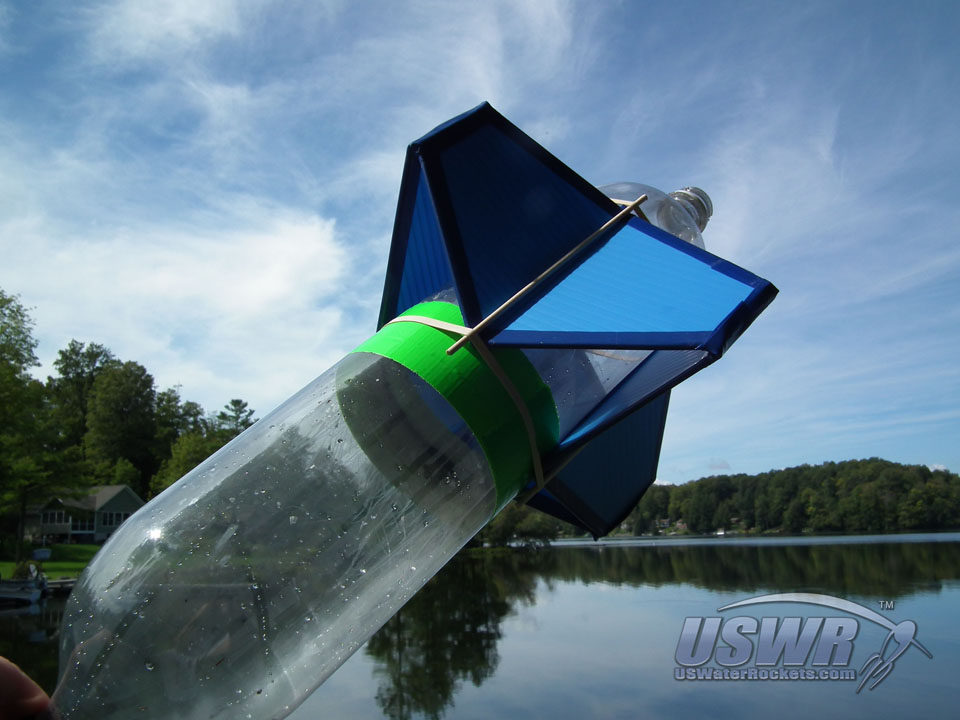Water Rocket Corriflute Recycling
Introduction:
A relatively new building material used in the construction of water rockets is a corrugated plastic sheet or corriboard. It is also known under the trade names of Corriflute, Coroplast, IntePro, Correx, Twinplast, or Corflute.This material is an extruded twin wall plastic-sheet produced from high-impact polypropylene resin with a similar make-up to corrugated cardboard, forming a light-weight tough material which can easily be cut with a craft knife. The material is available in a wide variety of colors and thicknesses (quite commonly 4 mm).
This material can be obtained from various hobby supply websites, but unless purchased in bulk, the cost per unit area combined with shipping costs can make the material impractical for most water rockets. However, there are a number of alternative methods for obtaining this material at little or no cost whatsoever. This tutorial explains how to repurpose used corriflute for your water rockets.
- Used Corriflute
- Paint Stripper/Remover
- Mineral Spirits
- Soap and Water
- Rubber Gloves
- Eye Protection
- Rags and paper Towels
- Stiff Brush
Materials Required:
Tools Required:
Step 1: Finding used corriflute:
The best place to obtain used corriflute is laying along the roadside. Yes, you read that correctly. The reason this is true is because corriflute is often used in the manufacture of advertising signs, particularly the signs advocating political campaigns during election cycles. You can get signs advocating your favorite party for free or for a nominal cost and recycle them when the election is over. If you know the shop where the signs are printed you can visit them and ask if they have any misprints or scraps you can have.Note: Typically it is illegal to tamper with political signs that don't belong to you, so do not take signs which other people have placed. If they place them on your property without permission then you can legally take them down.
If you don't care if your fins and rocket parts have printing on them, you can stop right now and use the corriflute as is. If you want to remove the printing and have fresh clean material then you can continue on with the tutorial.
Gallery
Step 2: Preparing to recycle:
Make sure to find a work area with good ventilation and always wear protective eyewear and rubber gloves. You will be using harsh chemicals to clean the corriflute and you need to follow all of the directions recommended by the paint remover manufacturer....
Gallery
Step 3: Apply the paint stripper:
While following the methods described in the paint remover directions, apply the stripper to the printed portion of the corriflute and allow the paint remover to work into the ink for the amount of time indicated in the directions.Gallery
Step 4: Remove the ink:
Using a rag and paper towels, wipe off the dissolved ink. Some inks will lift right off in sheets and other inks will turn into a liquid and will need to be soaked off. You may also use a stiff brush to work off any stubborn ink spots. You may want to repeat the stripper application a second time if the first attempt did not remove all of the ink to your satisfaction.Gallery
Step 5: Cleanup:
When you have cleaned the ink off and wiped away any leftover stripper, apply some mineral spirits to a rag or paper towel and scrub off any residue of ink before it solidifies. If you wait too long the ink will adhere back to the corriflute, so wipe it off as soon as possible.When you are finished removing the ink residue, you can wash the corriflute with dishwashing soap and water to remove any oils left over on the surface. Removing the oils will insure that any glues or adhesives you apply will not peel off.
Gallery
Finishing:
When dune, you will have clean and fresh corriflute for practically no cost. You can now use the corriflute to make components for your water rocket. You may wish to read over the [Box Fin Tutorial Link] to learn how to make a really simple set of fins for your water rockets.Additionally, we have discovered a few other sources for obtaining corriflute. One of our most interesting sources is a supplier of foldable corriflute bin containers http://flexcontainer.com/flexcon-corrugated/index.php that come in a rainbow of colors. We use a lot of these bins in our shop to hold various rocket parts and realized that they could be cut up and used as building material.
There are more and more products available made from this material and as it becomes more commonplace there will be even more sources.
Gallery
 Water Rocket Corriflute Recycling by
U.S. Water Rockets is licensed under a Creative Commons Attribution-NonCommercial 3.0 Unported License.
Water Rocket Corriflute Recycling by
U.S. Water Rockets is licensed under a Creative Commons Attribution-NonCommercial 3.0 Unported License.










